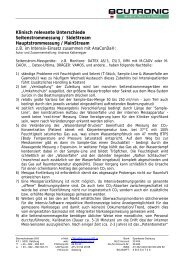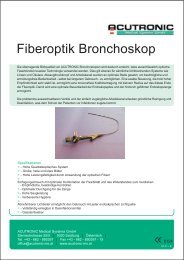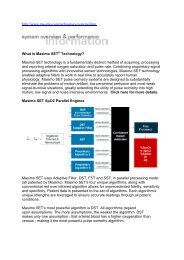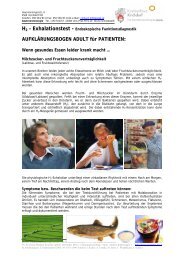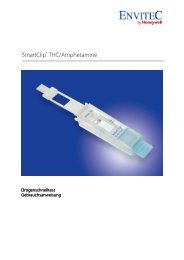Summary Carbon Monoxide Lurking within: The Danger of ...
Summary Carbon Monoxide Lurking within: The Danger of ...
Summary Carbon Monoxide Lurking within: The Danger of ...
You also want an ePaper? Increase the reach of your titles
YUMPU automatically turns print PDFs into web optimized ePapers that Google loves.
masimo corporation 40 parker irvine ca 92618 www.masimo.com<br />
Demystifying Carboxyhemoglobinemia - ED<br />
Causes <strong>of</strong> CO Poisoning<br />
<strong>Carbon</strong> monoxide is a gas produced by the combustion <strong>of</strong> carbon-containing fuels (oil, kerosene,<br />
gasoline, coal, wood) or the inadequate ventilation <strong>of</strong> natural gas. It is undetectable by humans.<br />
Faulty furnaces, motor vehicles, motor boat docks with swimming platforms, portable generators,<br />
stoves, gas ranges, and gas heaters are the most common sources <strong>of</strong> carbon monoxide<br />
poisoning. At one time, it was estimated that 29 percent <strong>of</strong> unintentional CO-related deaths were<br />
due to motor vehicles exhaust. 4 This rate has declined significantly since 1979, likely owing to<br />
improved emissions standards. Before catalytic converters, closed environment exposure to car<br />
exhaust could produce death <strong>within</strong> 30 minutes. 6 CO poisoning occurs most <strong>of</strong>ten in the fall and<br />
winter months, when the use <strong>of</strong> gas furnaces and alternative heat sources increases. 1 It also<br />
occurs when generators, which provide power to residences and businesses, are used in poorly<br />
ventilated areas. Portable generators are commonly used in situations where power interruptions<br />
are expected (hurricane zones, ice storms, flood regions). A lesser known source <strong>of</strong> carbon<br />
monoxide is the vapors from methylene chloride 7 , a compound commonly found in paint strippers.<br />
When the fumes are inhaled, it is converted in vivo to carbon monoxide.<br />
Pathophysiology<br />
Once in the bloodstream, CO has a multi-prong deleterious effect on the body. But despite the<br />
many adverse mechanisms outlined in Table 6 8-11 each produces the same result: preventing<br />
oxygen from reaching tissues thus causing tissue hypoxia:<br />
Table 6: Oxygen-limiting mechanisms <strong>of</strong> CO<br />
Limits oxygen transport <strong>The</strong> affi nity between carbon monoxide and hemoglobin is more<br />
than 200 times greater than that between oxygen and hemoglobin.<br />
As a result, CO more readily binds to hemoglobin,<br />
forming carboxyhemoglobin (COHb). 12<br />
Inhibits oxygen transfer CO further changes the structure <strong>of</strong> the hemoglobin molecule,<br />
which inhibits the already limited oxygen that has attached to<br />
be prematurely released into tissues.<br />
Tissue infl ammation <strong>The</strong> tissue damage caused by poor perfusion and lack <strong>of</strong><br />
oxygen attracts leukocytes to the damaged area. This initiates<br />
and sustains an infl ammatory response, causing further tissue<br />
damage with increased capillary leakage and edema. 12 This<br />
process results in a tissue reperfusion injury, similar to what is<br />
seen in patients who have suffered a myocardial infarction.<br />
Poor cardiac function Decreased oxygen delivery to, and utilization <strong>of</strong>, oxygen by the<br />
myocardium may cause tachycardia, arrhythmias or myocardial<br />
ischemia. 7 Long-term damage to the heart has been demonstrated<br />
even after a single moderate to severe CO exposure.<br />
Increased activation <strong>of</strong><br />
nitric oxide<br />
CO increases the production <strong>of</strong> nitric oxide, an important component<br />
in peripheral vasodilatation. In systemic infl ammatory<br />
response syndrome (SIRS), nitric oxide can increase secondary<br />
to CO, or induce CO secondary to hemolysis.<br />
Vasodilatation CO increases the production <strong>of</strong> nitric oxide. Nitric oxide causes<br />
vasodilation. Vasodilatation is responsible for decreased<br />
cerebral blood fl ow and systemic hypotension. 13 Nitric oxide is<br />
largely converted to methemoglobin in the body.<br />
Free radical formation Nitric oxide also accelerates free radical formation. Free<br />
radical formation causes endothelial damage and oxidative<br />
damage to the brain. 13




